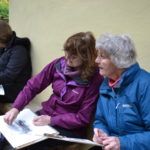31 Oct – 5 Dec | 1.30pm to 3.30pm | Tutor Karen Lester | £63 (5 weeks)
This course provides the opportunity to further develop your watercolour skills and gain confidence, exploring techniques such as glazing and creating lights and whites. With a focus on colour theory, learn how to mix colour effectively to create the muted colours for winter landscapes or shadows in still life.
This is a follow on course for those on the Watercolour course for Beginners or other previous beginners’ watercolour courses
Important Information
Please note there are no classes on the following dates:
Autumn term: 21 to 25 October; & 11 to 17 November 2019
What will the course or workshop cover and how will it be taught?
Following on from a little previous experience, further develop skills including –
- building on previous skills using washes and wet in wet techniques
- glazing techniques
- further techniques to make lights and whites
- effective colour mixing with a focus on muted colours
- developing personal colour palettes
Painting from Landscape images and Still Life, the emphasis is very much on practical individual experience with tutor-led demonstrations, discussion, example work and handouts which will support and guide you throughout.
What do I need to bring with me?
Watercolour paints, watercolour paper and drawing materials ( pencil, rubber etc)
Watercolour Paints – Bring any paints that you already have! Your tutor will discuss equipment and materials in more depth at the first session.
A suggested simple palette based on the primary colours, red, blue and yellow.
Artist quality paints are the best for pigment but a good student quality from a well-known brand such as Winsor and Newton Cotman series will give good results. Tubes are better, especially for washes. Suggested colours –
Yellow Ochre, Cadmium yellow // Ultramarine Blue, Cobalt Blue // Alizarin Crimson, Cadmium red //Paynes grey //Burnt Umber
- Paper – A good quality paper is essential. A heavy weight of watercolour paper with texture (it may say cold pressed or Not) of 200lb is ideal. Get a reasonable size such as A4 or bigger
- Brushes – Watercolour round brushes, in a range of sizes of small, medium and large size (eg 4, 8, 14). Look for soft synthetic watercolour brushes.
- Other – Big water pots x 2– eg. yoghurt pots
- Kitchen roll or cloths
- Masking tape
- Large plastic palette tray or old saucers/plates to mix paints
- Board- wood or card- old backs from picture frames are useful
Are there any additional costs?
None
About the tutor
Karen enjoys working with a range of painting and drawing media, including printmaking, sometimes combining these to create mixed media images. Each type of medium brings its own exciting possibilities and unique qualities, something she continually explores.
Her interest in Printmaking developed at Kendal College whilst completing a Foundation Degree in Drawing with the University of Cumbria.
Her work has been exhibited in galleries in Cumbria and Lancashire over the last 25 years and she has been involved with projects including Printfest and C-Art and runs occasional print workshops for the National Trust at Allan Bank, Grasmere as well as for private groups.
Karen is an experienced qualified teacher and has been teaching in the adult education sector since 2011 www.karenlester.com

PLEASE BOOK YOUR TICKETS IN ADVANCE OF YOUR VISIT
Brewery Members receive a 10% discount on most ticketed live performances and event tickets, sign in to your account to take advantage of these discounts.
All our ticket prices include a 50p-£1 commission. This fee helps us continue to fund our diverse programme. Creative learning classes & workshops are exempt.
Audio Description (AD) is available in Screen 1. Infrared audio system is available in both Cinema Screens 1 and 2. Induction loops (T) are in place in the Theatre, please ask for assistance on the door.
Some live events may carry strict age restrictions, these are outlined on our website. Under 16’s must be accompanied by an adult at all times during evening events.
Unwaged* – For those in receipt of Universal Credit, Working Tax credits, Job Seekers Allowance or Income Support. Discounts may not be applicable on certain events.




